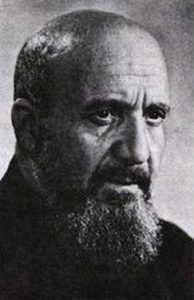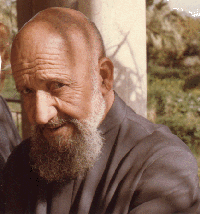 Отец Авраам Шмуэлоф, начитывающий текст, был уникальной фигурой в мозаике Ивритоязычной Католической общины в Израиле.
Отец Авраам Шмуэлоф, начитывающий текст, был уникальной фигурой в мозаике Ивритоязычной Католической общины в Израиле.
Он родился в 1913 г. в Бухарском квартале Иерусалима, в большой еврейской семье, приехавшей в Иерусалим из Ирана в 1900 г. Одно время он учился в «Коллеж-де-Фрер» в иерусалимском Старом Городе. Позже он будет говорить о своей юности и молодости как о диком времени в поиске удовольствий. В 1939 г. он вербуется в британскую армию и в 1941 г. с другими британскими солдатами в Греции попадает в плен к немцам. Следующие четыре года он проведет в лагерях военнопленных в Греции, Югославии и Германии.
В лагерях Авраам начал читать Библию и размышлять о личности Иисуса из Назарета. Дождавшись освобождения в 1945 г., он смог наконец осуществить свое намерение креститься. Прибыв по окончании войны в Англию, он явился в католическую церковь в Ньюкастле и принял Крещение. По возвращении в Иерусалим, он распрощался с семьей и поступил в бенедиктинский Успенский монастырь на Сионе. Год спустя он перешел в траппистский монастырь в Латруне и монашествовал там пять лет. В 1948 году Латрун оказался под иорданским Хашмитским Королевством, и аббат монастыря решил отослать еврейского монаха домой в Израиль – для его же безопасности. Пересекши границу через Ворота Мандельбаума, Авраам снова пришел в свой изначальный монастырь. Его послали изучать богословие – в Риме, потом в Бельгии и Германии, и в Успенский монастырь он вернулся только в 1956 году.
Визанитйский обряд, который он изучал в Германии, все больше привлекал Авраама. В конце концов он покинул Успенское аббатство и поступил в распоряжение Греко-Католической епархии Галилеи. В 1956 г. в Назарете Архиепископ Хаким рукоположил его в священство. Хорошо владея арабским, он преподавал в семинарии в Назарете, потом служил приходским священником в Сахнине, позже – в Джише; но быть еврейским священником в полностью арабской церкви было нелегко. В 1967 г., после войны, отец Авраам смог вернуться в Латрун, который теперь был внутри границ Государства Израиль. В последующие годы отец Авраам ездил из Латруна в Галилею, где он оставался на службе Греко-Католической церкви и ее епископа Йосефа Райи, но мира в душе это ему не приносило.
В конце 70-х отец Авраам перешел в доминиканскую общину Дома святого Исайи. Здесь он обрел некоторый мир – в общине, направленной на изучение иудейской традиции, на диалог с еврейским народом и пастырское окормление ивритоязычных католиков в Израиле. Особенно памятно его участие в одном из проектов тех лет: магнитофонной записи всей Библии – Танаха и Нового Завета. Его отличный иврит проявлялся в его записях, в его мессах, а также в его порой полемичных трудах и статьях.
Отец Авраам скончался в 1994 году и похоронен в Иудейских горах, в Пустыни Святого Иоанна. Он остался в памяти как просто «Абуна» («Батюшка») – динамичная, хотя и не без противоречий, личность в Ивритоязычной Католической общине в Израиле.
http://www.catholic.co.il/index.php?option=com_content&view=category&id=38&Itemid=246&lang=ru
Abraham Shmuelof

Abraham Shmuelof was born in 1913 in the Meah Shearim section of Jerusalem to a large Bucharan Ultraorthodox Jewish family which had migrated from Persia at the end of the 19thcentury. He would become a legendary figure in Jerusalem, journeying from being an Ultraorthodox Jew to Roman Catholicism, Trappist monk, Benedictine, returning to the Trappists and finally to serving in the Greek-Catholic Church in Galilee.
The youngest of sixteen children, he went to school at the “Collège des Frères,” and would become a companion of Menachem Begin in the Irgun (the military wing of Jewish Defense in Israel from 1935-1940). In World War II he joined the British army and fought in the famous Jewish legion. Captured in 1941, he became a prisoner of war. He was deeply moved by the reading of the New Testament which he had acquired in exchange for cigarettes. But only when he was released some four years later and returned to London, England, did he recognize Jesus as his Messiah and was baptized as a Christian. Back in Jerusalem, his family tried to persuade him to return to the Jewish faith, but he persisted and became a Trappist monk. For a brief time he stayed at the Trappist Monastery in Latroun. But when it was taken by the Jordanian army in 1948, he joined a Benedictine community and studied briefly in Rome. Wanting to announce Christ as Messiah, «Abuna» joined the Greek Catholic Church. He was ordained priest by Archbishop Hakim in Nazareth in 1956 and served the Melkite community as a parish priest at Gush Chalav, (he spoke perfect Arabic as well as his native Hebrew) and helped the bishop as secretary for Jewish affairs. As he encountered more and more difficulties in serving the Palestinian community, he found his true place at “La Maison d’Isaïe” in Jerusalem founded by the French Dominicans, where he collaborated on developing a Hebrew Liturgy with Fr. Jacques Fontaine. It was at this time that Fr. Abraham took on the task of recording the entire Tanak in Hebrew. Fr. Abraham always showed a great passion for the Hebrew language and often chided his young fellow Israelis for not speaking Hebrew well.
His later years were spent in Jerusalem where he frequently associated with the Jesuits at the Pontifical Biblical Institute. Fr. Francesco Rossi de Gasperis would often bring students and pilgrims to hear him recount his many stories in the Land of Israel. The last few years of his life were spent in Bethany, where he was convalescing at Casa Mater Misericordiae. He died there and was buried on March 23, 1994. His close relationship continued with the Dominicans and the Melkites, and that is why he is buried in their garden at the monastery of St. John in the Desert, just west of Jerusalem, below Moshe ‘Even Sapir, near ‘En Karem
The diffusion of the Audio Recordings has been entrusted to the Carmelites in light of Fr. Abraham’s devotion to St. Theresa of Lisieux. The original tape recordings were transferred to digital audio by Audio Scriptures International, and then transferred to mp3 files, divided according to chapters, by the Academy of Ancient Languages.These latter mp3 files are used in this rendition of the Hebrew Tanak. On-line links (as of July 2007) can be found at various sites: Academy of Ancient Languages; or at Mechon-Mamre. Both sites have links to the crystal clear recordings of Fr. Abraham’s reading of the entire Hebrew Bible.
(This information has been gathered from personal acquaintainces of Fr. Abraham Shmuelof by Michael Kolarcik, particularly that of Fr. Francesco Rossi de Gasperis, S.J.)
http://individual.utoronto.ca/mfkolarcik/AbrahamShmuelof.html





